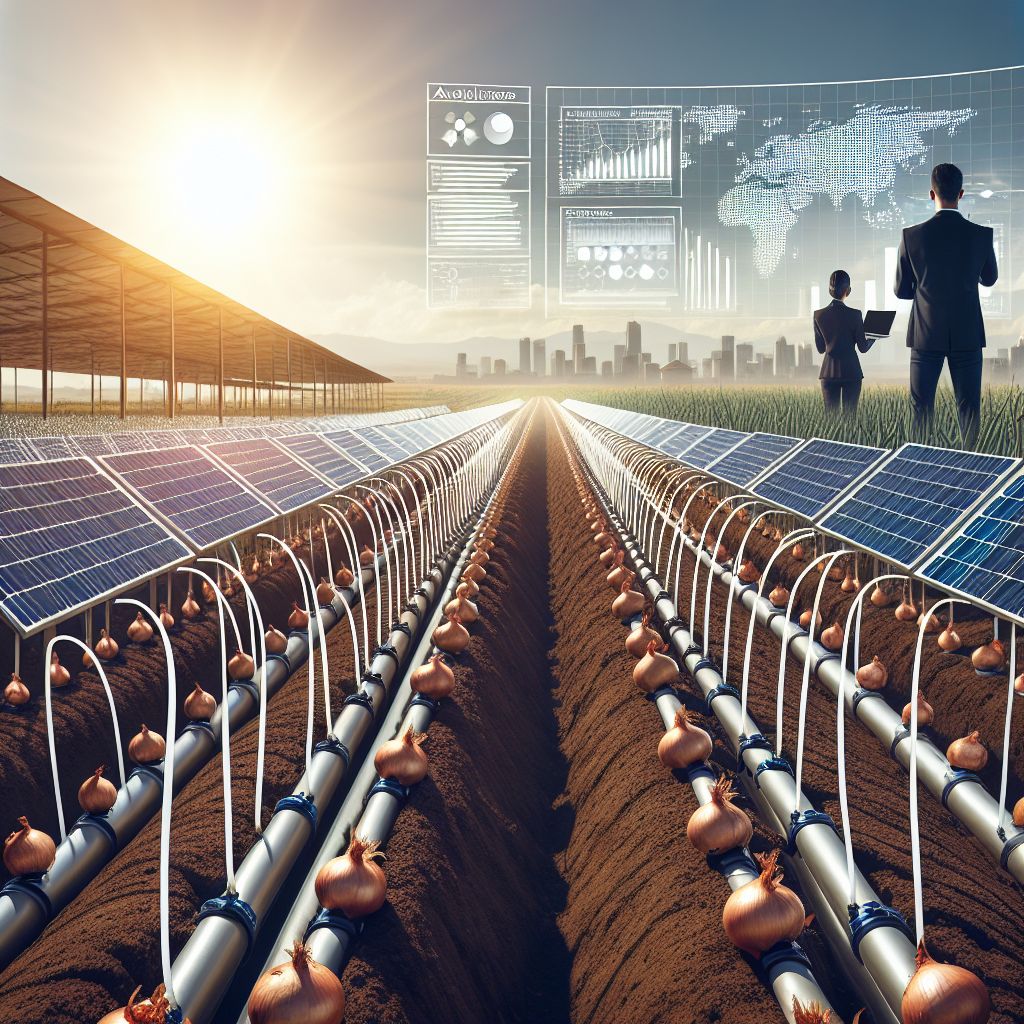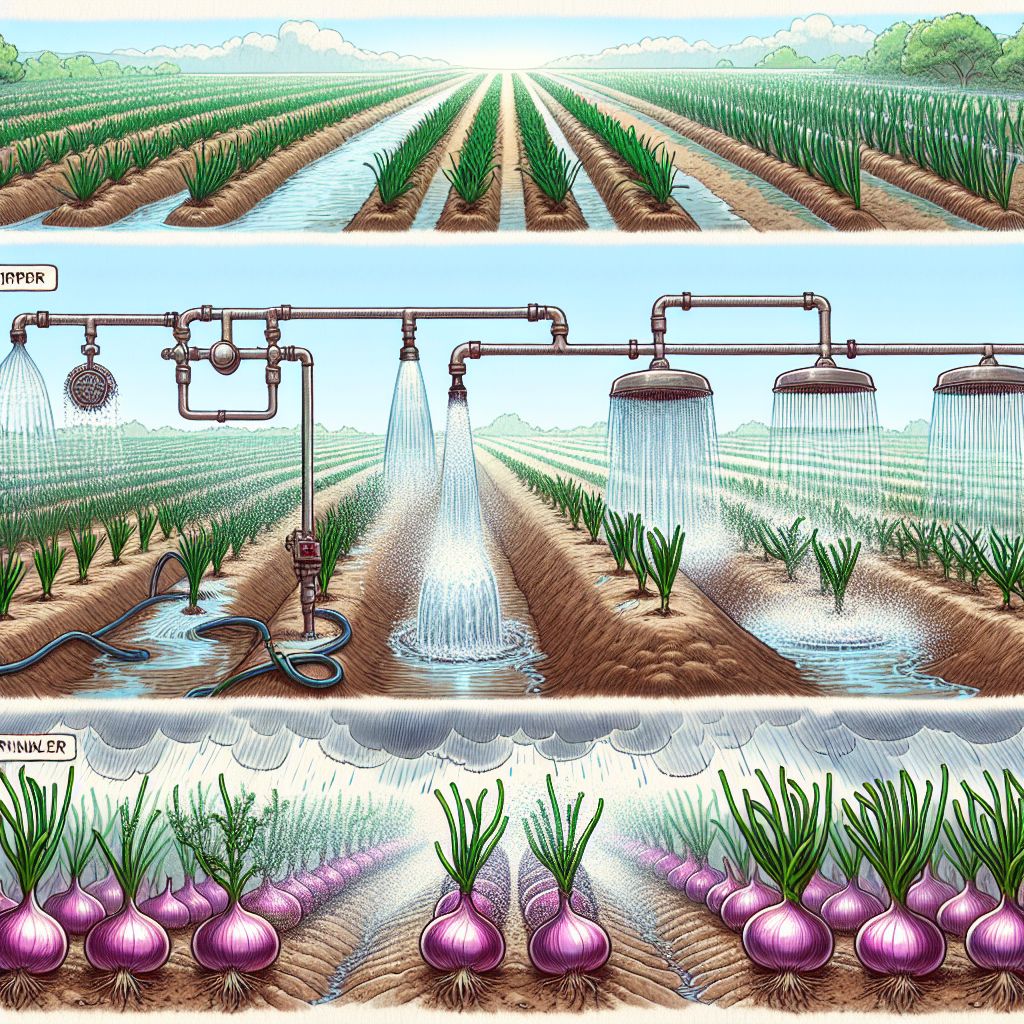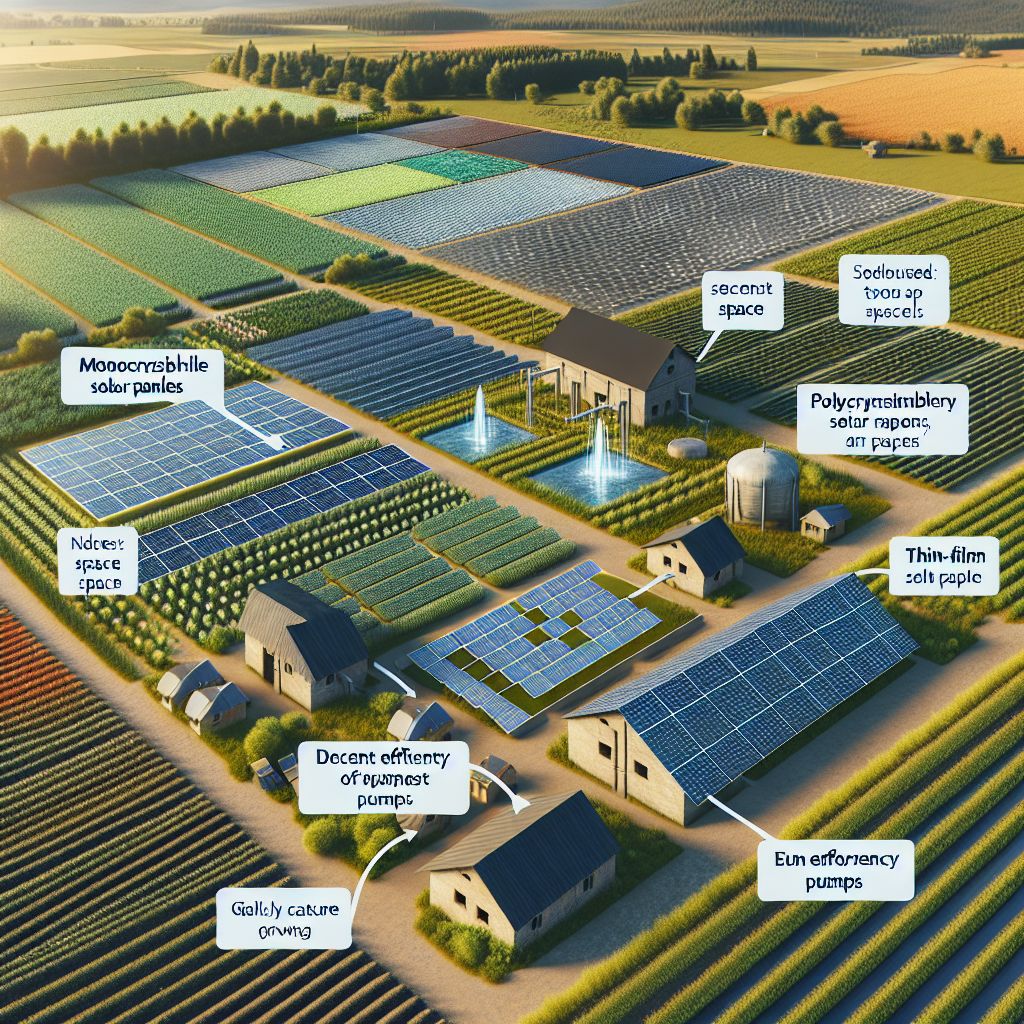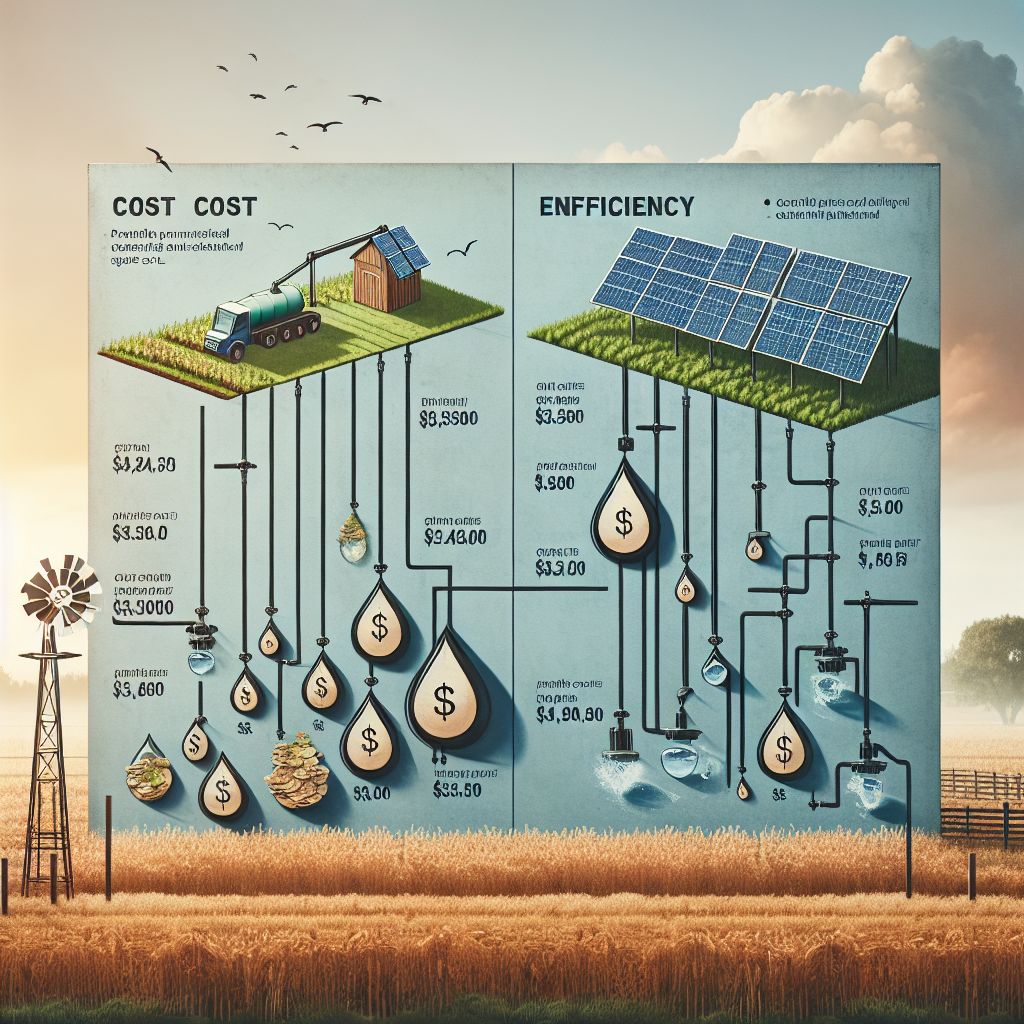
Key Takeaways
Solar irrigation systems offer a sustainable and cost-effective solution for watering onion crops.
Integrating solar energy into farming can reduce reliance on non-renewable energy sources and lower operational costs.
Drip irrigation, when powered by solar energy, is particularly efficient for onion farming, delivering water directly to the roots with minimal waste.
Understanding the types of solar panels and calculating energy requirements are crucial steps for setting up a solar irrigation system.
Investing in solar irrigation can yield long-term savings and increase the profitability of onion farming.
Why Combine Solar Panels with an Irrigation System
Imagine a farm where the energy of the sun not only nourishes the crops but also powers the very system that waters them. That’s the beauty of combining solar panels with an irrigation system. It’s a harmonious blend of nature and technology that leads to a greener, more self-sufficient way of farming. And when it comes to crops like onions, which are staples in kitchens around the world, efficiency in irrigation is key to a bountiful harvest.
Benefits of Integrating Solar Energy into Farming
When we harness the power of the sun, we tap into an endless source of energy that’s not only abundant but also free. By integrating solar energy into farming practices, growers can significantly cut down on electricity or diesel costs. It’s a smart move that makes the farm more resilient to energy price fluctuations. Besides that, solar energy is clean, reducing the carbon footprint of agricultural operations. This is a game-changer for eco-conscious growers who aim to produce crops sustainably.
How Solar Panels Enhance Irrigation Efficiency
Solar panels capture sunlight and convert it into electricity, which can then power irrigation systems. This setup is especially beneficial during the peak growing season when water demand is high and, conveniently, so is solar energy potential. With a solar-powered irrigation system, water can be pumped from wells or reservoirs without the need for grid electricity or fuel-powered generators. This means that once the initial setup is in place, the cost of watering crops like onions can drop significantly.
Environmental Impact and Sustainability of Solar-Powered Systems
Opting for solar irrigation systems is a big step toward sustainable agriculture. By reducing greenhouse gas emissions and conserving water, solar-powered systems help preserve the environment. Water is a precious resource, and as climate patterns become more unpredictable, it’s imperative that we use it wisely. Solar irrigation systems are precise and can be adjusted to provide the exact amount of water crops need, minimizing waste and protecting local waterways from runoff.

Different Irrigation Systems Used to Grow Onions on a Farm
Onions require consistent moisture, particularly during their bulbing phase, but they don’t like to sit in waterlogged soil. This makes the choice of irrigation system crucial. There are several methods farmers can use, each with its own set of advantages and challenges.
Overview of Drip, Sprinkler, and Furrow Irrigation Methods
Drip irrigation is like a targeted drink for plants: it delivers water right to the roots, where it’s needed most. This method is highly efficient and conserves water by reducing evaporation and runoff. Sprinkler systems, on the other hand, mimic rainfall and can cover large areas. They’re versatile but can be less efficient due to evaporation and wind drift. Furrow irrigation involves flooding rows of crops with water, which is a traditional method but can lead to water wastage and soil erosion.
Here is a table summarizing the pros and cons of different irrigation systems for growing onions:
|
Irrigation System |
Pros |
Cons |
|---|---|---|
|
Drip Irrigation |
– Efficient water usage, minimizes evaporation and runoff. 1, 3, 4 |
– Initial installation can be expensive. 1, 3 |
|
Sprinkler/Overhead |
– Inexpensive to install. 1, 4 |
– Promotes foliar diseases on pepper plants. 1, 4 |
|
Furrow/Flood |
– Simple system, low installation cost. 1, 3 |
– Very high water usage. 1, 3 |
Comparing Water Distribution Efficiency for Onion Crops
When it comes to onions, drip irrigation is often the top choice because it provides a controlled and precise water supply. This is important because onions have shallow root systems and are sensitive to overwatering. Sprinkler systems can still be used effectively, especially when water needs to be distributed over a larger area. Furrow irrigation is less common for onions due to the potential for waterlogging and uneven water distribution.
Cost and Increased Efficiency: Traditional (Furrow, and Sprinkler) Versus Modern (Drip) Irrigation Systems for Growing Onions
When we talk about cost and efficiency in farming, we’re looking at the big picture: not just the initial price tag, but also the long-term return on investment. Traditional irrigation methods like furrow and sprinkler systems have been around for ages, and they’ve served us well. But as we move forward, we’re seeing a shift towards more modern, efficient methods like drip irrigation, especially for water-intensive crops like onions.
Analyzing Initial Investment and Long-Term Savings
The upfront cost of setting up a drip irrigation system can be higher than traditional methods, but don’t let that initial number scare you. The long-term savings are where the drip system shines. With drip irrigation, water usage can be reduced by up to 60%, and because water is delivered directly to the roots, you’re also looking at better yields. This means that over time, the savings on water and the increased crop output can offset the initial investment.
Moreover, when you add solar panels to the mix, you’re slashing the energy bills, too. Solar energy is free once you’ve got the panels installed, and they have a life expectancy of 25 years or more. So, while the initial setup for a solar-powered drip irrigation system might be higher, the costs over time are significantly lower compared to traditional systems.
Operational Benefits of Modernized Irrigation Technologies
But it’s not just about money. Modern irrigation technologies like drip systems are easier to manage and can be automated to save time and labor. They are less labor-intensive than traditional methods, which often require manual intervention. Additionally, they offer a level of precision that ensures water is not wasted, which is not only good for your pocket but also for the planet.

Different Solar Panels You Can Add to the Irrigation System to Grow Onions on a Farm
Now, let’s talk about solar panels. If you’re considering solar irrigation, choosing the right type of solar panel is crucial. There are a few different types of panels out there, and each has its own set of pros and cons.
Types of Solar Panels Suitable for Farm Irrigation
For farm irrigation, the most commonly used solar panels are monocrystalline and polycrystalline. Monocrystalline panels are more efficient and require less space, but they come with a higher price tag. Polycrystalline panels are more affordable and still offer decent efficiency. There’s also thin-film solar panels, which are lightweight and flexible, but they’re less efficient and might not be the best choice for a permanent installation like an irrigation system.
Right below is a table looking at all the different solar panel options:
|
Solar Panel Type |
Efficiency Range |
Advantages |
Disadvantages |
|---|---|---|---|
|
Monocrystalline |
17-22% |
Highest efficiency, space-saving, long lifespan. 2 | |
|
Polycrystalline |
15-17% |
Lower efficiency, requires more space. 2 | |
|
Thin-Film |
10-13% |
Lightweight, flexible, good temperature coefficient. 2 |
Lowest efficiency, requires large area. 2 |
|
Portable Solar Panel Systems |
Varies based on panel type |
Designed for irrigation needs, easy to move and relocate. 1, 3 | |
|
Hybrid Solar Panels |
Varies based on components |
Can combine solar with other energy sources like wind, increased reliability. 4 |
More complex system, higher cost. 4 |
Monocrystalline panels provide the highest efficiency in a compact area but at a higher upfront cost (2, 3). Polycrystalline panels offer a balance of efficiency and cost (2, 3). Thin-film panels have lower efficiency but perform better in high temperatures (2). Portable solar panel irrigation systems allow flexibility in placement and relocation as needed (1). Hybrid systems increase reliability by combining solar with other renewable sources but add complexity (4). The optimal choice depends on factors like available space, budget, local climate conditions, and specific irrigation requirements for the Onions.
Calculating Energy Requirements for Onion Farming
Calculating your energy requirements is a step you can’t skip. You need to know how much power your irrigation system will need so you can size your solar array accordingly. To do this, consider the power consumption of your pumps and any other equipment, the hours of operation, and the peak sun hours in your location. It’s a bit of math, but it’s essential for ensuring your system will be able to keep up with your onions’ thirst.

Cost and Increased Efficiency in Growing Onions: Regular Irrigation Systems Versus Solar Irrigation Systems
When we weigh the costs and efficiency of regular irrigation systems against solar-powered ones, there are a few key points to consider. Regular systems might have lower upfront costs, but they’re at the mercy of energy prices and less efficient water use. Solar irrigation systems have higher initial costs but lead to substantial savings and efficiency gains in the long run.
For instance, running a diesel-powered pump for a traditional sprinkler system can be costly, especially with rising fuel prices. On the other hand, a solar-powered drip system uses free energy from the sun and delivers water directly to the plant’s roots, reducing the amount of water needed and virtually eliminating the energy costs.
Here’s an example to bring it home: A farm spends $1000 annually on diesel to power their irrigation system. By switching to a solar-powered system, they eliminate that recurring cost. Even if the solar setup costs $5000, it pays for itself in five years, and with solar panels lasting 25 years or more, that’s 20 years of cost-free irrigation.
Comparative Analysis of Operating Costs
Let’s break down the operating costs. For a regular irrigation system, you have ongoing fuel and maintenance costs. For a solar irrigation system, the main costs are the initial purchase and installation of the panels and system, plus minimal maintenance. Over time, the cost per gallon of water delivered can be significantly lower with a solar system.
Consider also the potential for government incentives or subsidies for renewable energy investments, which can further reduce the effective cost of a solar irrigation setup. It’s worth doing some research to see what might be available in your area.
Assessing the Return on Investment for Solar Irrigation Systems
The return on investment (ROI) for solar irrigation systems can be impressive. By reducing or even eliminating fuel and electricity costs, the savings start accumulating quickly. Additionally, because these systems are often more efficient and can lead to increased yields, the financial benefits can be substantial.
It’s important to do a detailed cost-benefit analysis for your specific situation, taking into account your current costs, the scale of your operation, and local conditions. This will give you a clear picture of how quickly a solar irrigation system could pay for itself on your farm.
Conclusion:
Solar irrigation systems represent a smart investment for onion farmers looking to increase efficiency and sustainability. By reducing water and energy consumption, these systems not only save money but also contribute to a healthier environment. With careful planning and consideration of the specific needs of your farm, solar-powered irrigation can be a game-changer for your agricultural practices.
Final Thoughts on Adopting Solar Irrigation for Onion Farming
As we wrap up, remember that adopting solar irrigation for onion farming is more than just a trend; it’s a commitment to a sustainable future. By choosing this path, you’re making a statement that you care about the environment and are willing to invest in the long-term health of your farm. Embrace the sun’s power, water your onions wisely, and watch as your farm becomes a beacon of sustainability.
Frequently Asked Questions (FAQ)
Transitioning to solar irrigation can raise many questions. Let’s tackle some of the most common queries to give you a clearer picture of what to expect.
Can solar irrigation systems be used in all climates?
Absolutely! Solar irrigation systems are versatile and can be used in various climates. The key is to properly size the system for your specific location and weather patterns. In areas with less sunlight, you may need more panels to capture the necessary energy. With the right setup, any farm can benefit from solar irrigation.
What is the lifespan of a solar irrigation system?
Solar panels themselves can last 25 years or more, making them a long-term investment. The other components of the system, like pumps and controllers, will have their own lifespans, but with proper maintenance, you can expect your solar irrigation system to serve your farm efficiently for many years.
Are there government incentives for using solar irrigation in agriculture?
In many places, yes. Governments around the world are offering incentives to encourage the adoption of renewable energy sources, including solar irrigation in agriculture. These can take the form of tax credits, rebates, or grants. Check with your local authorities to see what incentives may be available to you.
How much maintenance is required for solar irrigation systems?
Solar irrigation systems are relatively low maintenance. The solar panels need to be kept clean and free of debris to operate efficiently, and the mechanical parts of the irrigation system, such as pumps and filters, should be checked regularly. However, compared to traditional systems, solar irrigation requires less upkeep overall.
Can I retrofit my existing irrigation system to run on solar power?
Many existing irrigation systems can be retrofitted to run on solar power. The feasibility will depend on the specifics of your current system, but in most cases, it’s entirely possible. You’ll need to add solar panels and a solar pump, and possibly make some adjustments to the control system. A professional with experience in solar irrigation can help you determine the best approach for your farm.
Incorporating solar power into your farm’s irrigation system is a smart move that pays off both financially and environmentally. By doing so, you’re investing in the health of your land and contributing to a sustainable future for agriculture. Remember, every drop of water that’s efficiently distributed using the power of the sun is a step towards a greener planet.







Leave a Reply